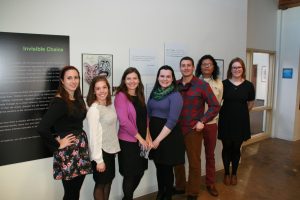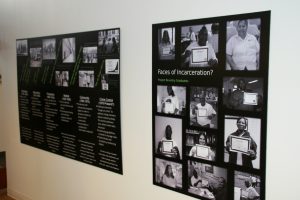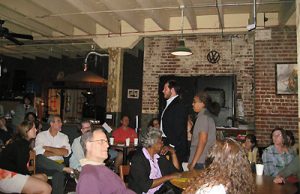Public history is both a practice and approach; it is the investigation and interpretation of the past with and for non-academic audiences. HST 367 focuses on a major theme in community and local history in the Piedmont Triad order to challenge to students to address interpretive problems and possibilities as historians working in public settings. Past offerings have presented students’ work in public exhibitions, which you can read about below.
Students interested in public history should consider completing an interdisciplinary minor in Cultural Heritage and Preservation Studies.
Fall 2014
The Fall 2014 Public History course project was a public exhibit on the history of incarceration and the challenges that former prisoners in our community face when they return home. The class collaborated with Project Re-entry, a successful program that offers educational and support services to prisoners before and after release. The students visited a local prison to participate in a Project Re-entry class, interviewed former offenders, and curated their artwork and writing into an exhibit titled “Release: From Stigma to Acceptance.” The exhibit opened with a public reception on January 17, 2015, at Sawtooth School for Visual Art. After a two month display at Sawtooth, the exhibit moved to the Wake Forest campus.
The Winston-Salem Chronicle published a preview of the students’ exhibit, interviewing History major and Public History student Mallory Allred and Professor Lisa Blee for the piece.
Professor Blee was also featured in a Humanities Institute podcast:
 Students worked over the course of the Fall 2015 semester to research, design, and write this exhibit about former prisoners’ experiences with re-entry. Students presented their work-in-progress to the collaborative partner, artists, and professional curators at several points in the semester.
Students worked over the course of the Fall 2015 semester to research, design, and write this exhibit about former prisoners’ experiences with re-entry. Students presented their work-in-progress to the collaborative partner, artists, and professional curators at several points in the semester.
 The students organized a panel on the topic of incarceration and re-entry at the opening reception on January 17. Student Mallory Allred speaks about the students’ visits to Forsyth Correctional Center at the beginning of the semester and how the experience impacted their project.
The students organized a panel on the topic of incarceration and re-entry at the opening reception on January 17. Student Mallory Allred speaks about the students’ visits to Forsyth Correctional Center at the beginning of the semester and how the experience impacted their project.
 The Public History class partnered with Project Re-entry to interview former offenders and curate their artwork for the exhibit. Rebecca Sauter, the co-founder and program coordinator at Project Re-entry, discusses the program’s work to support former offenders during the panel discussion.
The Public History class partnered with Project Re-entry to interview former offenders and curate their artwork for the exhibit. Rebecca Sauter, the co-founder and program coordinator at Project Re-entry, discusses the program’s work to support former offenders during the panel discussion.
 The educational exhibit features several large panels and the curated art and quotes from former offenders. The exhibit was on display at Sawtooth School for Visual Art until the end of February 2015.
The educational exhibit features several large panels and the curated art and quotes from former offenders. The exhibit was on display at Sawtooth School for Visual Art until the end of February 2015.
Spring 2011
 In the spring of 2011, Assistant Professor Lisa Blee offered Issues in Public History (HST 367/667) for the first time. Over the course of the semester, students developed community-based research projects around several themes in local history. At the conclusion of the course, the students presented their educational exhibits and documentary films at a public event at Krankies Coffee.
In the spring of 2011, Assistant Professor Lisa Blee offered Issues in Public History (HST 367/667) for the first time. Over the course of the semester, students developed community-based research projects around several themes in local history. At the conclusion of the course, the students presented their educational exhibits and documentary films at a public event at Krankies Coffee.
 On visits to Old Salem, Bethabara Park, and Reynolda House, the students learned about the major challenges facing public history professionals as they seek to balance accessibility, entertainment, preservation, and interpretation. The course also introduced students to the notion that public memory is everywhere – a fact just as evident in commemorative statues and buildings as highways and razed neighborhoods. “Public history,” explained student Emily Garcia, “can get students out of the classroom to local sites and requires them to think critically about their surroundings and ask questions like historians.” Indeed, social values can be read on the built environment; what we choose to preserve is a statement about what aspects of the past matter to us today. The task for students in this course was to investigate what Winston-Salem values and what we can learn about ourselves in the process.
On visits to Old Salem, Bethabara Park, and Reynolda House, the students learned about the major challenges facing public history professionals as they seek to balance accessibility, entertainment, preservation, and interpretation. The course also introduced students to the notion that public memory is everywhere – a fact just as evident in commemorative statues and buildings as highways and razed neighborhoods. “Public history,” explained student Emily Garcia, “can get students out of the classroom to local sites and requires them to think critically about their surroundings and ask questions like historians.” Indeed, social values can be read on the built environment; what we choose to preserve is a statement about what aspects of the past matter to us today. The task for students in this course was to investigate what Winston-Salem values and what we can learn about ourselves in the process.
To quote future educator Emily Garcia, “Learning by doing is the best kind of pedagogical practice.” The twenty students in the class formed into six groups and conducted original research on different topics in local history: tobacco, art, gardening, historic preservation, and school desegregation. Professor Blee provided the broad strokes of published regional history so the students could understand how their topic fit into larger trends – or had been ignored altogether in scholarly accounts. From their interviews, students came to understand what long-time residents remember and believe to be important. “As I collected individuals’ stories,” Garcia noted, “it was so interesting to piece their accounts together with newspaper articles and official narratives of secondary sources. As a public historian, I felt as though I had a responsibility to mesh these stories together and paint a larger picture.” The groups worked through various public history issues as the semester progressed: finding knowledgeable people to interview, filling in gaps in official records, creating a coherent narrative from different or even conflicting accounts, paring down the information into a concise and interesting public format, and respectfully but responsibly interpreting controversial events and points of view.
 Garcia reflected on interpretive choices her group made when their research uncovered unflattering aspects of the city: “Not many communities would be proud to be classified as a resegregated area. We combated this issue by simply presenting the facts. We did not make grand statements or assumptions. Rather, we provided the numbers and maps and the viewer was able to make a conclusion.”
Garcia reflected on interpretive choices her group made when their research uncovered unflattering aspects of the city: “Not many communities would be proud to be classified as a resegregated area. We combated this issue by simply presenting the facts. We did not make grand statements or assumptions. Rather, we provided the numbers and maps and the viewer was able to make a conclusion.”
The students presented their findings before a public audience gathered in the performance space at Krankies Coffee. The students’ projects encouraged Winston-Salem residents to learn, think, question, and discuss what art, tobacco, schools, preservation, and gardens have meant and should continue to mean to the community. The exhibits will remain on display at Krankies for several weeks, but the impact for the students will be long-lasting. Garcia reflected at the end of class: “As I continued to do research I began to feel a part of the community. Being a transient young person, this is one of the first times I felt a sense of belonging to a community… Even though Winston-Salem has its flaws, I feel a connection to the city and its history. It has made such an impact that I am seeking a job in the Winston-Salem Forysth County School system.”

